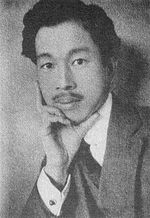Gotō Keiji
Gotō Keiji ( Japanese 後 藤 慶 二 ; born October 29, 1883 in Tokyo ; died February 3, 1919 ) was a Japanese architect of the Taishō period .
life and work
Gotō Keiji graduated from Tokyo University as an architect in 1909 . He then entered the Ministry of Justice. His most important work is the design for the Toyotama Correctional Facility, built in 1915, which became his main legacy as he died soon after.
Meiji period architecture was largely an eclectic mix of Japanese and Western stylistic elements with some new ideas. During this time Gotō worked on a combination of architectural expressiveness and the new reinforced concrete construction and thus contributed to the development of architecture in Japan. His way of thinking about architecture was strongly influenced by the idea of " Taishō democracy ", which primarily concerned itself with the welfare of the individual.
In addition to the prison building mentioned, Gotō left behind a small number of residential and other buildings. The "History of Theater Buildings in Japan" ( 日本 劇場 建築 史Nihon Gekijō Kensetsu-shi ) was published posthumously in 1925 .
Remarks
- ↑ The prison, Toyotama Kangaku ( 豊 多 摩 監獄 ) or Toyotama Keimusho ( 豊 多 摩 刑 務 所 ), later called 中 野 刑 務 所 Nakano keimusho , was located in the municipality of Nogata in Toyotama County (1932–43 Tokyo City , then Nakano District ) of the prefecture . It closed in 1983. Nakano District Administration, 中 野 区 の 住 ま い ・ ま ち づ く り 年表 .
literature
- Tazawa, Yutaka: Gotō Keiji . In: Biographical Dictionary of Japanese Art. Kodansha International, 1981. ISBN 0-87011-488-3 .
| personal data | |
|---|---|
| SURNAME | Gotō, Keiji |
| ALTERNATIVE NAMES | 後 藤 慶 二 (Japanese) |
| BRIEF DESCRIPTION | Japanese architect |
| DATE OF BIRTH | October 29, 1883 |
| PLACE OF BIRTH | Tokyo |
| DATE OF DEATH | February 3, 1919 |

